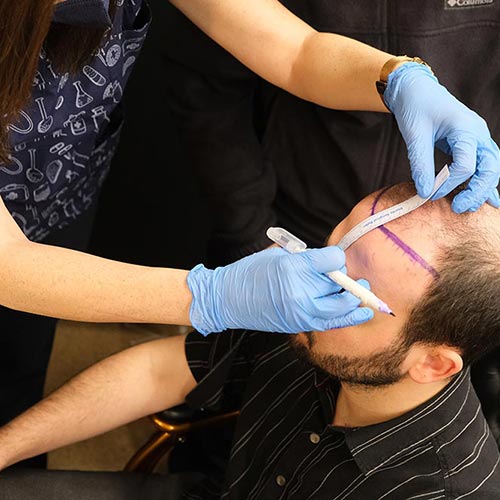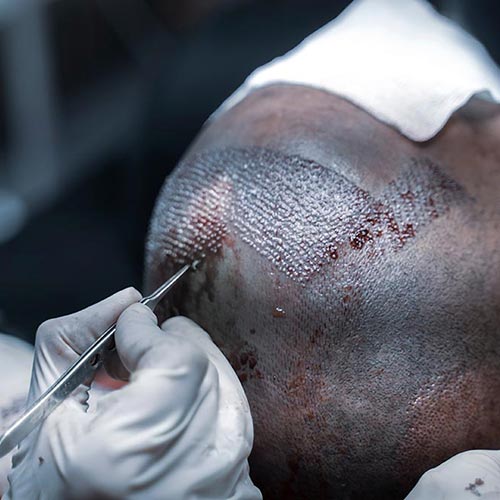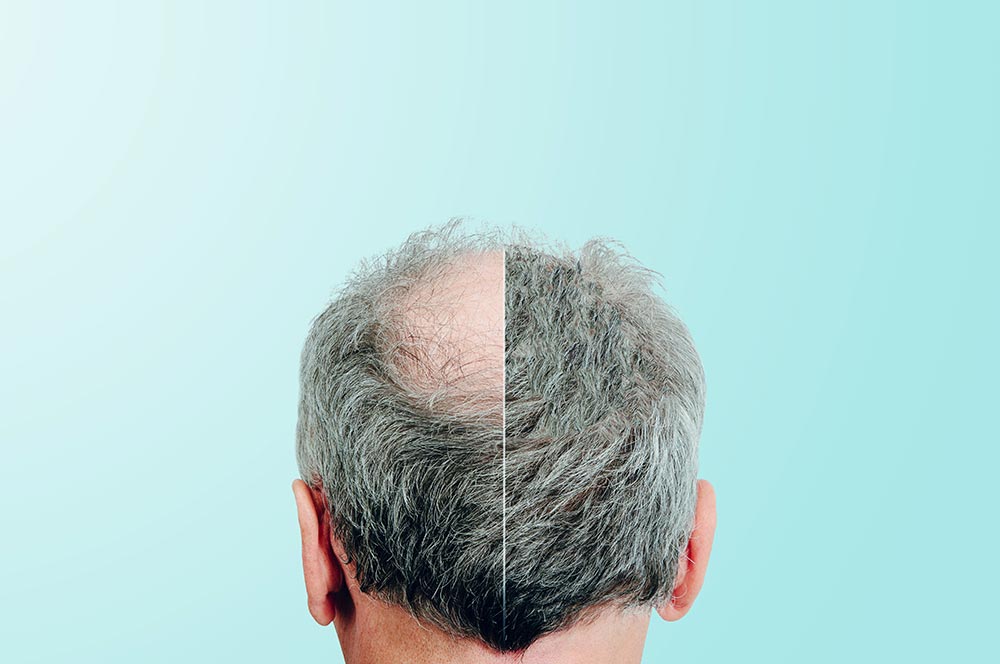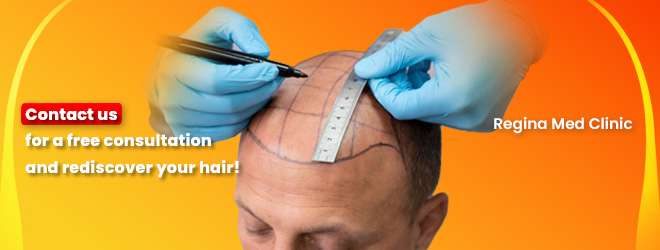How Should the Sleeping Position Be After a Hair Transplant?
The sleeping position after a hair transplant is crucial for the healthy attachment of hair follicles and the smooth progression of the healing process. After the operation, hair follicles are in a sensitive state, and incorrect sleeping positions can damage them. Especially during the first week, sleeping in a position that does not put pressure on the hair follicles ensures that they remain in place and accelerates the healing process. Sleeping on your back is recommended to prevent the transplanted area from coming into contact with the pillow or any other surface.
Keeping the head slightly elevated helps improve blood circulation in the scalp, reducing swelling. Additionally, adjusting the sleeping position correctly minimizes the risk of infection. Neck-support pillows should be used to keep the head stable during sleep. Adopting the proper sleeping habits after a hair transplant directly affects the long-term success of the operation.


İÇİNDEKİLER
How Should You Sleep on the First Night After a Hair Transplant?
The first night after a hair transplant marks the beginning of the recovery process and is one of the most critical periods. During this time, when the hair follicles are highly sensitive, the correct sleeping position must be chosen. Sleeping on your back is the safest option for the first night. This position prevents the transplanted area from coming into contact with any surface, avoiding damage to the follicles. Additionally, keeping the head slightly elevated helps reduce swelling in the scalp. Using two pillows can ensure the head is at the proper height while sleeping.
Positions such as sleeping on your side or face down must be strictly avoided on the first night. These positions can put pressure on the hair follicles, causing them to dislodge. Surface contact can also increase the risk of infection. It is also important to ensure that the pillows used on the first night are clean and hygienic. These precautions help the hair follicles attach healthily and accelerate the healing process.

What Are the Harms of Sleeping Face Down After a Hair Transplant?
The face-down sleeping position is one of the riskiest positions after a hair transplant, as it makes protecting the follicles more challenging. In this position, the transplanted area comes into direct contact with the pillow or mattress, putting pressure on the follicles and potentially dislodging them. Additionally, sleeping face down restricts blood circulation in the scalp, making it harder for the follicles to receive sufficient nourishment. Therefore, face-down sleeping should be strictly avoided during the first week.
Another harm of sleeping face down is the increased risk of infection. Prolonged contact with the pillow or surface can cause irritation to the scalp and negatively affect the healing process. Moreover, this position can increase swelling in the transplanted area and damage the follicles. To support the healing process and preserve the results of the hair transplant, sleeping on your back is the best choice.
Is Sleeping on Your Side Harmful After a Hair Transplant?
Although sleeping on your side may seem less harmful than the face-down position, it is still not recommended after a hair transplant. During side sleeping, there is a high risk of the transplanted area coming into contact with the pillow, which can put pressure on the hair follicles and cause them to dislodge. It can also restrict blood circulation in the scalp, slowing down the healing process of the follicles.
Friction caused by side sleeping may irritate the transplanted area and negatively impact the crusting process. Side sleeping should be avoided during the first week, and the back-sleeping position should be preferred. Following the recommended sleeping position for the duration advised by your doctor is crucial for the successful completion of the recovery process after a hair transplant.
Supportive Pillows to Use on the First Night
On the first night after a hair transplant, using supportive pillows is recommended to keep the head in the correct position. Neck-support pillows minimize head movement, reducing pressure on the hair follicles. These pillows also prevent the transplanted area from coming into contact with the pillow or other surfaces, thereby protecting the hair follicles.
When choosing a pillow, soft and breathable materials should be preferred. Ensuring that the pillows used on the first night are clean and hygienic helps reduce the risk of infection. Supportive pillows that keep the head elevated at a 30-45 degree angle improve blood circulation and help reduce swelling. Proper use of supportive pillows accelerates the healing process after a hair transplant.
How High Should the Head Be While Sleeping After a Hair Transplant?
Maintaining the correct head elevation during sleep is a critical part of the recovery process after a hair transplant. The proper head height regulates blood circulation in the scalp, allowing the follicles to receive adequate nourishment. Additionally, elevating the head helps reduce swelling in the scalp and speeds up the healing process. Failure to keep the head sufficiently elevated can put pressure on the hair follicles and increase swelling.
To ensure proper head height, neck-support pillows should be used. These pillows keep the head stable and prevent damage to the follicles. It is recommended to keep the head elevated at a 30-45 degree angle. Furthermore, using soft and hygienic pillows helps reduce the risk of infection. Maintaining the appropriate head elevation during sleep contributes to achieving positive results after a hair transplant.
Why Is Head Elevation Important?
Keeping the head elevated offers numerous benefits during the recovery process after a hair transplant. This position improves blood circulation, delivering more oxygen and nutrients to the hair follicles. Additionally, elevating the head helps reduce swelling and facilitates the distribution of fluid buildup (edema) in the scalp. Insufficient head elevation can slow blood flow and prolong the healing process.
Head elevation also reduces pressure on the scalp, ensuring the hair follicles attach securely. Sleeping at the correct elevation for the first week lowers the risk of dislodging the follicles. Therefore, maintaining and carefully adjusting the head’s position is essential during the post-transplant period.
How to Choose the Right Pillow?
Choosing the right pillow after a hair transplant is crucial for maintaining the proper head elevation and protecting the hair follicles. Neck-support pillows, which help keep the head stable while sleeping, are among the most preferred options during this period. These pillows limit head movement, prevent the transplanted area from contacting the pillow, and minimize pressure on the hair follicles. Soft, breathable, and hypoallergenic materials prevent scalp irritation and offer hygiene advantages.
Proper pillow selection not only protects the hair follicles but also ensures comfort for the head and neck. In addition to supportive pillows, using sterile pillowcases during the first days post-transplant reduces the risk of infection. When choosing a pillow, look for a design that keeps the head elevated at a 30-45 degree angle. This way, the hair follicles are protected, and swelling is effectively minimized.
The Correct Position to Reduce Swelling
Keeping the head in the correct position after a hair transplant plays a major role in controlling swelling that may occur on the scalp. Swelling is typically observed during the first few days following the procedure, and maintaining the proper head position minimizes this issue. Sleeping on your back with the head elevated allows gravity to help distribute fluid buildup (edema) and accelerates the healing process. It is recommended to use two supportive pillows to keep the head elevated while sleeping.
In addition to maintaining the correct position, consuming plenty of fluids and engaging in small movements that improve blood circulation can help reduce swelling. Incorrect sleeping positions, particularly face-down sleeping, may increase swelling and complicate the healing process. By carefully following your doctor’s recommended sleeping position, you can protect both the hair follicles and the overall health of the scalp.
Consult Now!
Fill out the form to get detailed information about the hair
transplant process and personalized solutions tailored for you!
How Many Days After a Hair Transplant Can You Return to a Normal Sleeping Position?
The transition to a normal sleeping position can vary depending on the recovery process after a hair transplant. Typically, you can return to your normal sleeping position after the first 10-14 days, once the hair follicles have fully attached and the sensitivity in the transplanted area has decreased. During this period, it is recommended to sleep on your back with the head elevated. Before transitioning to a normal sleeping position, a doctor’s evaluation is essential to assess the recovery of the follicles.
The timeline for returning to a normal sleeping position may vary depending on an individual’s healing speed, the hair transplant method, and skin type. If the recovery process is progressing as expected, a careful transition to a side-sleeping position may be possible. However, even during this stage, it is important to avoid putting pressure on the hair follicles and minimize contact with the pillow. Transitioning to a normal sleeping position too early can damage the hair follicles and lead to undesirable outcomes.
The Importance of Sleeping Position in the First Days
During the first days after a hair transplant, the correct sleeping position is crucial for protecting the hair follicles. At this stage, the follicles have not fully settled and are extremely sensitive to pressure and friction. An incorrect sleeping position can dislodge the follicles and prolong the healing process. Sleeping on your back with the head elevated should be preferred during the initial days. This position not only supports blood circulation in the scalp but also helps reduce swelling.
The hygiene of the sleeping environment is as important as the sleeping position. Regularly changing pillowcases reduces the risk of infection on the scalp. Additionally, careful selection of pillows ensures the hair follicles remain undamaged. These precautions during the first days are key steps in supporting the long-term success of the hair transplant.
What Determines the Transition Time to a Normal Sleeping Position?
The transition time to a normal sleeping position depends on the healing speed of the hair follicles and individual characteristics. The first week after the operation is the most sensitive period for the hair follicles. During this time, sleeping on your back is recommended to prevent any damage to the follicles. From the second week onward, a side-sleeping position may be allowed under doctor supervision. However, this transition can vary depending on the complication-free progress of the healing process and the condition of the transplanted area.
Even during the transition to a normal sleeping position, pressure on the hair follicles must be avoided. Proper positioning during the first days also allows for a quicker return to normal sleeping habits. If any complications or discomfort occur, transitioning to a normal sleeping position may need to be delayed, and doctor recommendations should be followed.
The Effect of Sleeping Position on Hair Follicles
position eliminates pressure on the hair follicles, allowing them to attach more securely. During the first weeks, as the hair follicles adapt to their new position, sleeping on your back is recommended. This position prevents damage to the follicles and accelerates the healing process.
An incorrect sleeping position can cause irritation to the hair follicles, increase crusting, and raise the risk of infection. Additionally, pressure on the hair follicles can cause them to dislodge. Adopting the correct sleeping position not only supports the healing process but also contributes to more successful long-term results after a hair transplant.
The Effect of Sleeping Position on Recovery After a Hair Transplant
The sleeping position is critically important during the recovery process after a hair transplant. Sleeping in the wrong position can put pressure on the hair follicles, causing them to dislodge or become damaged. This can delay the healing process and increase the risk of infection. By adopting a suitable sleeping position, the hair follicles can be protected from external factors. During the first week, sleeping on your back with the head slightly elevated supports the healing process. This position prevents contact between the transplanted area and surfaces, ensuring the follicles remain safe.
Another benefit of the correct sleeping position is improved blood circulation in the scalp. Proper blood flow facilitates the delivery of oxygen and nutrients to the hair follicles. As a result, the follicles heal more quickly and become stronger. Considering the impact of sleeping position on recovery, it is essential to adhere to the positions recommended by your doctor.
The Impact of Incorrect Sleeping Positions on Infection Risk
An incorrect sleeping position is one of the key factors that increase the risk of infection after a hair transplant. Sleeping face-down or on your side causes direct contact between the hair follicles and the pillow or bed. This contact can lead to irritation, inflammation, or infection of the follicles. Additionally, sweating during sleep or bacteria accumulated on the pillow can infect the transplanted area. Maintaining a hygienic sleeping environment and choosing the correct sleeping position during the first days minimizes the risk of infection.
The risk of infection is not limited to contact alone; pressure on the hair follicles can also cause tissue damage and negatively affect the healing process. Therefore, it is crucial to properly support the head during sleep and protect it from pressure. Choosing the right pillow and keeping the head stable not only reduces the risk of infection but also ensures the healthy healing of the hair follicles.
The Contribution of Proper Position to Blood Circulation
Maintaining the correct head position during sleep after a hair transplant supports blood circulation. Sleeping on your back with the head elevated regulates blood flow, delivering oxygen and nutrients to the hair follicles. This process helps the follicles heal faster and attach more securely. When blood circulation is restricted, the healing of hair follicles slows down, and the risk of follicle loss increases.
The correct position also facilitates the distribution of swelling. Reducing scalp swelling accelerates the healing process and minimizes discomfort. Keeping the head stable and supported with a pillow during sleep helps maintain healthy blood circulation. Therefore, the sleeping position is not just for comfort but is also essential for the success of the recovery process.
The Benefits of Sleep Regulation for the Recovery Process
Regular and sufficient sleep is one of the essential components of the recovery process after a hair transplant. During sleep, the body repairs itself, and tissue regeneration accelerates. This contributes to the attachment of hair follicles and speeds up the healing process. Disrupted sleep patterns can slow down recovery and decrease the success rate of the hair transplant.
A consistent sleep routine also helps reduce stress levels and maintain hormonal balance. This supports the healthy development of hair follicles. Additionally, quality sleep reduces scalp irritation and makes the recovery process more comfortable. Paying attention to sleep patterns after a hair transplant ensures more successful long-term results.
What Precautions Should Be Taken During Sleep After a Hair Transplant?
To protect the hair follicles and support the healing process during sleep, certain precautions should be taken. First, it is important to keep the head in the proper position. Sleeping on your back prevents pressure on the hair follicles and reduces the risk of damage. Additionally, the choice of pillow should be made carefully, and a neck-supportive, soft pillow should be used. Creating a hygienic sleeping environment is another measure that minimizes the risk of infection.
To control the reflex to scratch during sleep, hands should be kept clean, and nails should be trimmed short. Moisturizers and lotions recommended by the doctor can be used to alleviate itching. These precautions taken during the first days not only speed up the healing process but also ensure the healthy attachment of hair follicles.
Precautions to Protect Hair Follicles
To protect the hair follicles, it is essential to prevent any contact with surfaces during sleep. Throughout the first week, sleeping on your back should be preferred. Additionally, neck-support pillows should be used to keep the head stable. These pillows reduce the risk of damaging the hair follicles and support the healing process.
Ensuring a hygienic sleeping environment is equally important for protecting the follicles. Pillowcases should be changed regularly and, if possible, have antibacterial properties. Harsh movements and the reflex to scratch should also be avoided to prevent damage to the scalp. These precautions ensure the safe recovery of hair follicles after a hair transplant.
Methods to Prevent Scratching During Sleep
During the post-hair transplant period, itching is a natural part of the healing process, but it must be controlled during sleep. To alleviate itching, suitable moisturizers can be applied to the scalp. Additionally, maintaining scalp hygiene is an effective method for reducing itchiness. A clean pillowcase and a comfortable environment for the hair follicles can further minimize the itching sensation.
To prevent scratching during sleep, hands should be kept clean, and nails should be trimmed short. This minimizes the risk of damaging the hair follicles through involuntary movements. It is also recommended to use anti-itch sprays or lotions as advised by the doctor to make this process more comfortable.
Supportive Materials for Comfortable Sleep in the First Days
During the first days after a hair transplant, supportive materials can be used to ensure comfortable sleep. Neck-support pillows help keep the head in the correct position and reduce pressure on the hair follicles. These pillows also keep the head stable, preventing unwanted movements during sleep.
Antibacterial pillowcases protect the hair follicles from infection while allowing the scalp to breathe more easily. Pillows made from soft and hypoallergenic materials should be preferred. The use of supportive materials allows for a more comfortable recovery process.
Travel and Sleeping Position After a Hair Transplant
One of the most important factors to consider when traveling after a hair transplant is the sleeping position. Long journeys can create situations that may damage the hair follicles. Proper support of the head during travel helps protect the follicles. Neck-support pillows can be used to keep the head stable during airplane or car journeys.
Care should be taken to ensure that the hair follicles do not come into contact with any surfaces during travel. Additionally, paying attention to sleep habits before and after the journey contributes to a healthy recovery process. To protect the hair follicles, it is essential to maintain hygienic conditions and keep the head in a stable position while traveling.
How Should the Sleeping Position Be During Flights or Journeys?
Keeping the head stable during flights or long-distance journeys is crucial for protecting hair follicles after a hair transplant. Neck-support pillows help limit head movement and prevent pressure on the hair follicles during travel. Throughout the journey, a position close to an upright, back-supported sitting posture should be preferred, and care should be taken to avoid leaning the head forward.
Maintaining a hygienic environment is another important factor to consider during travel. The pillows used during the journey should be clean and prevent direct contact with the scalp. By protecting the hair follicles throughout the trip, the recovery process can progress healthily.
Methods to Protect Hair Follicles During Long Journeys
Measures taken to protect hair follicles during long journeys directly affect the success of the recovery process after a hair transplant. Neck-support pillows can be used to prevent any contact with surfaces during travel. Keeping the head upright throughout the journey also improves blood circulation and helps reduce swelling.
It is important to ensure that any accessories used during travel are breathable and made of soft-textured materials. Paying attention to scalp hygiene after the journey helps reduce the risk of infection. These simple precautions during the process ensure more successful hair transplant results.
Consult Now!
Fill out the form to get detailed information about the hair
transplant process and personalized solutions tailored for you!

